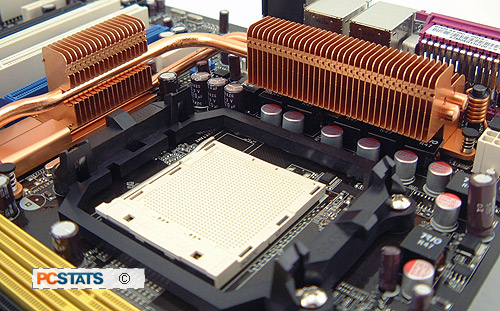When it comes to external
mass storage, bandwidth has always been an issue, and external Serial ATA makes
even IEEE 1394b's 800Mbps bandwidth look paltry by comparison. Asus has placed
an external SATA (eSATA) port on the rear I/O of the M2N32 WS Professional
motherboard.
 This connection
uses a slightly modified SATA cable (not included), which is better suited to
external connections. Standard internal Serial ATA cables are sufficient for
internal connections, but SATA-IO governing body decided a while back that the
external version should be a somewhat different format, thus creating the eSATA
standard. eSATA enclosures for hard drives are widely available, and the great
thing is that hard drives connected over this standard are just as fast as
internal devices.
This connection
uses a slightly modified SATA cable (not included), which is better suited to
external connections. Standard internal Serial ATA cables are sufficient for
internal connections, but SATA-IO governing body decided a while back that the
external version should be a somewhat different format, thus creating the eSATA
standard. eSATA enclosures for hard drives are widely available, and the great
thing is that hard drives connected over this standard are just as fast as
internal devices.
The
connectors are hot swappable, so it makes adding and removing an massive
external hard drive about as complex as plugging in a USB memory key. For anyone
who as ever had to move Gig's of data over a USB cable, eSATA is simply awesome.

The Asus Q Connector
The Q-Connector makes connecting front panel I/O, USB or IEEE 1394 headers on the Asus M2N32
WS Professional motherboard a snap. Since the standards are different per manufacturer,
cases often come with front panel connectors broken down to one pin per line. If
you're a tweaker that makes removing the motherboard a more tedious task but
with Q Connector, you can connect all the pins to the proper Q connector then
connect that to the motherboard when you're ready.
Removing the motherboard to do some maintenance? Simply
remove the Q Connector from the board and plug it back in when you're set. Asus
even labels the individual pin values from ground to power and data! Just make
sure you line up the pin outs properly, in a dark area it might be difficult to
tell.
Silent Chipset
Thermal Solution - no
more rattling mini-fans
The Asus M2N32 WS Professional motherboard
has a collection of copper heatpipe-based thin fin heatsinks covering its
chipsets. The nVIDIA nForce 590 SLI chipset generates a fair share of heat,
requiring more cooling than. The nForce northbridge and southbridge chipsets are cooled
by a totally silent thermal solution - so there are no small fans to fail over
time, no small fans to make noise, and no small fans to get clogged with dust.
The
nForce 590 SLI MCP has a finless chunk of copper mounted
on it, with a heatpipe snaking its way around slots and onboard
devices towards the copper northbridge heatsink. Two heatpipes connect the Northbridge heatsink
to a large thin fin copper heatsink mounted to the processor power supply MOSFETs.
The thin copper fin heatsink on the 8-phase power supply
MOSFETs to the left of the AMD AM2 socket harnesses the exhaust airflow from the
processor fan for its cooling. A clever solution for sure, and one
that most motherboard manufacturers have embraced as a quiet way of managing the
thermal output from chipsets. As always, it's important to remember that if water
cooling is used here, you have to point a fan in the direction of these copper
heatsinks.

The nVIDIA nForce 590 SLI chipset gets pretty hot
under load, but in our experience with the Asus M2N32 WS Professional we found
it's passive chipset solution quite effective at keeping temperatures in check.
